Float Trips in Late Spring
Posted on January 23rd, 2024
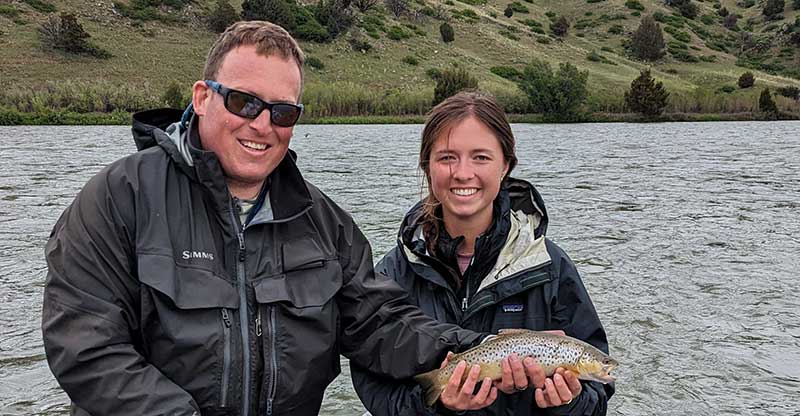
Late spring is prime time on the lower Madison River.
Late Spring Float Trips: Introduction
Late spring, here meaning from the beginning of the heavy spring melt in the first or second week of May through its conclusion in late June or early July, is prime time for trout fishing in many parts of the United States. In the Rockies, it’s not. This is particularly true for anglers who want to float free-flowing rivers like the Yellowstone, Boulder, and Stillwater rather than those right below dams, like the Lower Madison and Missouri.
The issue is the spring melt that raises all area rivers and turns most into raging brown chocolate milkshakes for at least a few weeks. During this timeframe, river float trips turn to tailwaters: the Madison and Missouri Rivers. These rivers downstream of dams stay clear. Therefore all that the high water they experience does is flush lots of insects and other foods into the drift for the trout to gorge on. In contrast to other rivers, tailwater rivers offer great float fishing at this time.
There’s one other factor that can influence fishing in late spring: runoff breaks. Runoff breaks are periods of cool or cold and usually dry weather that pause the spring runoff for a day or two at a time on freestone rivers, particularly the Yellowstone upstream from Livingston and the Boulder.
When a runoff break occurs, the trout in freestone rivers go bananas, feeding heavily on stonefly nymphs and streamers. If you happen to be here in May or the first three weeks of June when flows are dropping and water clarity is 18 inches or more, fishing on freestones can be better than it is almost any other time of year. You just can’t plan for these breaks, because they’re utterly dependent on day-to-day weather.
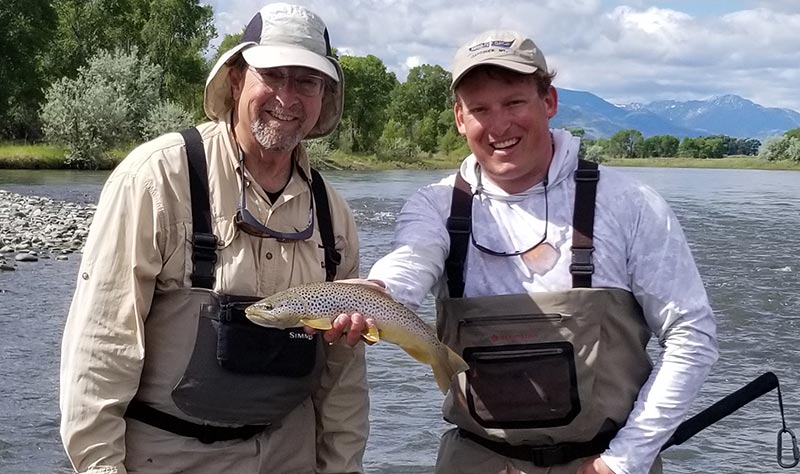
This brown came on the Yellowstone River during a runoff break around June 20, 2019, right before the river blew out again. The Yellowstone did not drop into fishable shape for good until July 7 that year.
Other good guided trip options this time of year are our power boat trips and private lake trips. As a matter of fact, this is the one period when these alternative trips are definitely better choices than float trips if you want to fish from a boat. That said, for many anglers nothing can compete with drifting down a river on a boat propelled by oars. Read on for info on where and how we do it through most of May and June.
Late Spring Float Trips: Quick Facts and General Information
- Best Waters: The top rivers in late spring are the lower and upper Madison and the Missouri downstream of Holter Dam. The Jefferson can be good some years late in this period, and during cold spells the Boulder and Yellowstone can be amazing. These cold spells can’t be planned for and the fishing only lasts a day or two at a time, though.
- Three Top Reasons to Come in Late Spring: 1.) You are eager to fish the lower Madison River, 2.) You are eager to fish the Missouri River when it fishes “easiest,” if not “best,” or 3.) This is when you can come, and you would rather float a river than a lake or take a walk trip.
- Three Top Reasons to Avoid Late Spring: 1.) Most rivers are too high and muddy to float, particularly the Yellowstone and Stillwater, 2.) Crowds are high on the rivers that are floatable, and 3.) Except during hatches, dry fly fishing is poor.
- Perfect Clients: Clients of any skill level who are coming at this time of year and would rather float-fish a river than fish a river from a power boat or fish a lake.
- What Late Spring Does Best: Provides the best fishing of the season on the lower Madison and Missouri Rivers.
May and some portion of June is runoff season in Montana, when the high mountain snow melts at last and turns every river, stream, creek, trickle, and rivulet that isn’t immediately downstream of a large dam into a raging chocolate brown torrent full of sticks, logs, and debris up to and including dead livestock and game animals. Sometimes this period even extends into early July, though with the effects of global warming this happens less and less often.
Needless to say, this is not the time to float freestone rivers, as rivers that aren’t protected by dams are known. It’s not that the fishing is so-so. It’s that the rivers are dangerous to even float, much less fish.
There are a few rivers that remain good at this time within our operations area. The Lower and to a lesser extent the Upper Madison are closest to Livingston. The Missouri River downstream of Holter Dam near Craig and Wolf Creek, Montana is further afield, but probably the best overall option. In fact this is usually the best period on the Missouri overall, provided anglers are willing to fish deep with nymphs to rack up the numbers if the trout aren’t rising. The crowds that swarm the “MO” at this time attest to the quality of the fishing.

This Lower Madison rainbow trout ate a caddis pupa suspended beneath a dry. This is one of the larger fish you can expect from the Lower Madison using this technique rather than fishing deep with crayfish or imitations of other large food items.
Our primary float trip option in late spring is the Lower Madison River, which is located about 30 minutes from Bozeman, about an hour from Livingston. We also run a few trips on the Upper Madison and multi-day trips on the Missouri, most of the latter with repeat clients.
Crowds on all rivers low and clear enough to float in late spring are generally high. There’s just no getting around it. Lots of people come to Montana expecting everything to be good in May and early June, as it is in many other parts of the country, and they are all clustered onto fewer rivers than usual. The Missouri gets hit hard, in particular.
Late Spring Float Trips on the Lower Madison
On the Lower Madison, most large trout get caught on streamers, crayfish imitations, and San Juan Worms. Sometimes the highest numbers of trout also take these flies, but the Lower Maddy is an insect factory by mid-late May and most days see good insect hatches from sometime in mid-late morning through evening.
Caddis hatches in particular often blanket the river, as the photo below can attest. There can also be several species of mayflies as well as stoneflies. Because of all the bugs, we typically have clients fish dries and dry-dropper combos when feasible. The best dry and dry-dropper fishing here occurs when cloud cover is heavy. The Lower Madison is a shallow stretch of river, so the fish often don’t rise when the sun’s bright for fear of ospreys and eagles.
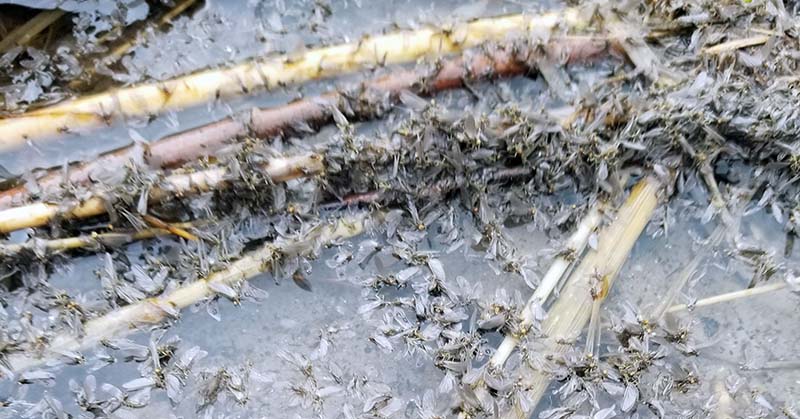
Vast numbers of caddisflies on the Lower Madison.
Most rising trout on the Lower Madison run small. The fish above was a very good rainbow for the dry-dropper technique. Most fish caught this way except during ideal weather conditions will run smaller. Small browns and rainbows are most common, but there are also good numbers of westslope cutthroat now, a new addition to the Lower Madison in the past few years. Like all cutthroat trout, these westslopes like to rise. They average a bit larger than most of the rainbows and browns we see rising. The fish below is a good example.
Half-day and full-day trips are available on the Lower Madison, and both trip types make a good deal of sense. Full-day trips allow us to get out in front of the crowds, while half-days will allow us to slot in well behind everybody to “match the hatch” on the upper end of the Lower Madison most guides are well past when the fish start rising. The Lower Madison tends to be crowded, but we can shed a lot of these crowds by getting out in front of them or staying on late.
We often fish quite slowly on Lower Madison floats, especially when the trout start rising. There are many good riffles and islands where the guide can stop the boat to let anglers work to pods of rising fish, and anglers so inclined also have the opportunity to get out and wade fish good spots. In general, we’ll fish a longer float and move faster when fish aren’t likely to rise, and fish slow and methodical when the weather and water conditions look conducive to hatches.
>>>>>>>>>>>>>> Return to Float Trips Page
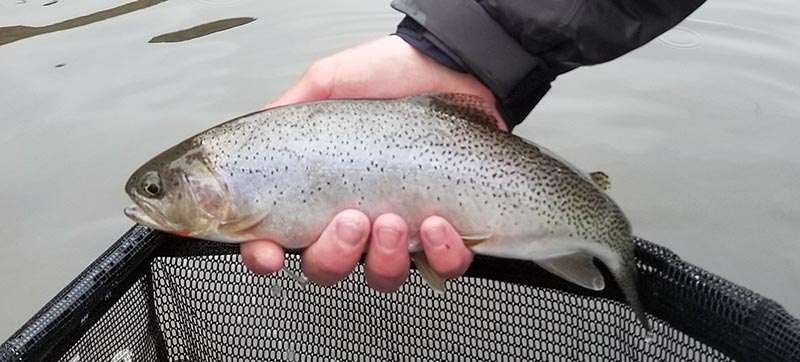
Average westslope cutthroat from the Lower Madison. The numbers of these native trout are increasing due to a successful reintroduction effort.
Float Trips in Early Spring
Posted on January 23rd, 2024
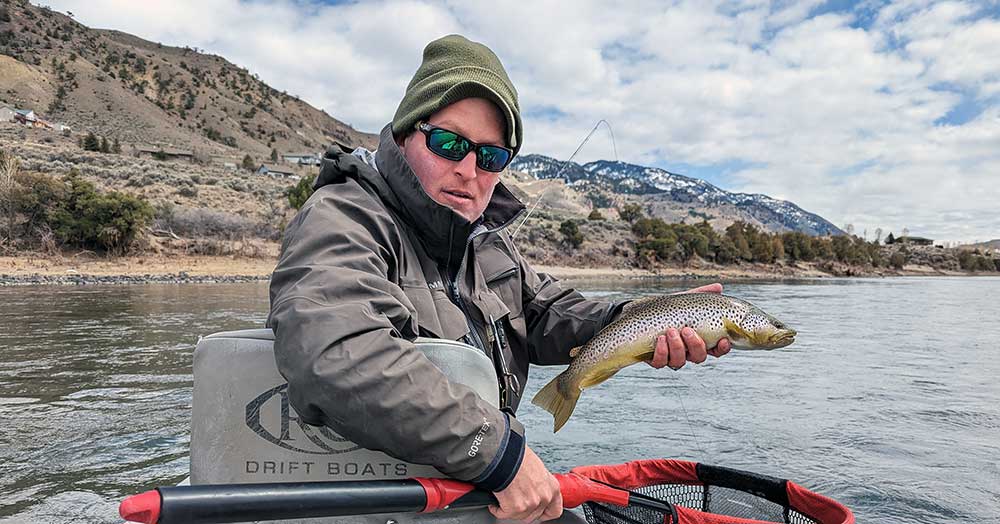
Early spring is prime season for larger fish.
Early Spring Float Trips: Introduction
Early spring float fishing in Montana is the best-kept secret in area fly fishing. Larger rivers fish very well at this time as the trout wake up from the long winter. Some dry fly fishing is possible, but the real draw is targeting big fish using subsurface tactics.
Angler crowds are minimal, the big fish are on the hunt, and there’s even a shot at dry fly fishing when it’s warm (or skiing at Bridger Bowl or Big Sky on off days, if it’s cold). What’s not to love?
The weather and water conditions, mostly. It might be bitter cold and snowing, it might be warm with howling winds. The rivers might be crystal clear or they might be chocolate brown with an early taste of the spring melt. These are the dice you roll when you book an early spring float trip. Not daunted? Read on.
Early Spring Float Trips: Quick Facts
- Best Waters: The top rivers in early spring are the entire Yellowstone except the shallowest stretches of Paradise Valley, and perhaps the lower Madison and Boulder Rivers.
- Three Top Reasons to Come in Early Spring: 1.) This is prime time for larger fish, especially rainbow and rainbow-cutthroat hybrid (cuttbow) trout. 2.) Crowds are low to nonexistent on most rivers. 3.) The fishing in early spring is just different than it is the rest of the year.
- Three Top Reasons to Avoid Early Spring: 1.) Dry fly fishing is limited. 2.) Weather and water conditions are inconsistent (it might be 15 degrees and snowing sideways, 50 with good fishing conditions, or 80 and sunny with a chocolate milk river). 3.) Fewer fisheries are good in early spring than during peak season.
- Perfect Clients: Experienced anglers eager to accept inconsistent weather and water conditions to fish nymphs and streamers for high-average and potentially really big fish, without the fishing crowds of summer and fall. Early spring is especially good for anglers who’ve been to Montana in the summer or early fall and want to see something different.
- What Early Spring Does Best: Produces good numbers of larger rainbows and some browns using indicator-nymphing techniques.
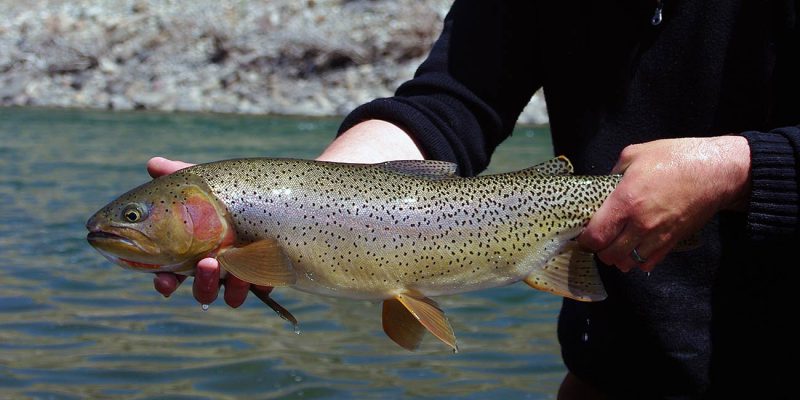
The largest rainbow and rainbow-cutthroat hybrid trout we see on the Yellowstone River are often caught on early spring float (or float-wade) trips. We got three this size in about two weeks, including two in one day.
Early Spring Float Trips: The Fishing
Early spring begins when the winter ice recedes enough to make floating safe and lasts until the heavy spring runoff hits freestone rivers like the Yellowstone sometime in early May, or once in a while the last few days of April.
This is the last truly “underfished” time of year in most areas within our operations area. On most rivers, we’re unlikely to see another boat during this period. Even on the Lower Madison, which sees the most pressure at this time of year, we’re unlikely to see more than a handful.
Despite the lack of pressure, this is a great time of year to float area rivers. The trout have the feedbags on to recover from the rigors of winter and the rainbow and cutthroat trout are preparing to spawn in tributary creeks, and are therefore aggressive.
It’s not uncommon for the largest fish of the year to come at this time, particularly rainbows. Because the crowds are low and the shots at big fish, we do more “personal” fishing on the Yellowstone River in early spring than during the rest of the year combined. One glorious day in late March Walter caught two fish over 23 inches long in an hour on the Yellowstone, and he never saw another angler or boat that day. Need we say more?
Early spring tactics are primarily subsurface. Our usual technique is to nymph with a big stonefly trailing something smaller, with a streamer rod at the ready as a changeup option.
The fish often gather in big numbers in small areas at this time, whether they’re sitting out the winter cold in pods or preparing for their spawning runs. For this reason, in early spring we often stop the boat and fish small areas hard, either anchored up or by using the boat mostly as transportation, then getting out to fish the likely spots on foot.
Unlike during the summer and early fall periods, we never fish dries in early spring unless we see rising fish. With the water still in the 30s or 40s, the fish simply don’t want to burn the energy to rise unless there are enough bugs to make it worthwhile. That said, the last few days of early spring on the Yellowstone can see some of the best dry fly fishing of the year.
This is the fabled Mother’s Day caddis hatch. This bug comes off in the millions or billions and drives the fish wild, provided the river is clear. This is a tough hatch to plan for, as often the river blows out with runoff right at the beginning of the hatch, but if you can hit it right, this might be one of the best days of fishing of your life.
Note that the Yellowstone does get crowded when the caddis pop, because every other guide in the state knows that this event causes spectacular fishing, too.

Large trout of all species often put on the feedbags right at the beginning of spring runoff. Walter caught this brown on the last day the river was clear enough to fish before blowing out for the spring melt. Notice how brown the water is in the background.
Early Spring Float Fishing in Montana: Where?
By far our favorite river to guide in early spring is the Yellowstone. It is clear most of the time, though warm weather can muddy it for a day or two as low-elevation snow melts, especially when the warm weather is accompanied by rain.
When the Yellowstone does get some early mud, the lower Madison is a great option. Further afield, the Missouri below Holter Dam is always great in early spring, and sees less traffic now than it does a few weeks later. The Boulder River is too cold through most of early spring, but it gets warm enough and high enough to float in late April and stays clear about a week later than the Yellowstone does, which makes it a great secondary option.
The major downside of early spring is the weather. “Spring” in Montana is not like spring in warmer places. It might be 15 degrees in the morning. It might snow all day. Worse, it might spit a mix of rain and snow. The wind often howls. It might also be 80 degrees and turn the rivers filthy with early snowmelt down from the mountains.
Floating can therefore be rather uncomfortable when the weather is bad, and the fishing can be unproductive when the weather is “good.” The somewhat variable water and weather conditions carry over to the fishing: it’s not consistent. Sometimes it’s great, but it can be tough too, especially if you’re after big numbers of fish rather than larger fish.
During early spring, half-day trips are better choices that full-days most of the time. This is especially true in March. Later in April, and especially in the few days of May before the runoff hits, the water warms and the fish get more aggressive, meaning full days are also a great option. Regardless of trip duration, we won’t meet early. There’s seldom any need to be on the water before 10:00AM.
Early 2024 Streamflow and Fishing Conditions Forecast
Posted on January 22nd, 2024
Greetings to clients old and new.
I’m putting up this post to help all of you plan your summer fishing trips to the Yellowstone area, or really Montana in general.
Simply put, it’s looking like all of Montana is in for an extremely low snowpack and resulting low streamflows. This is going to shift the timing for good fishing much earlier in the summer than normal, and it’ll probably make for very poor late summer conditions. These conditions will probably include lots of closures and lots of fires.
That bombshell dropped, I’ll also note that all photos on this page are from the 2023 season, which was pretty productive overall.
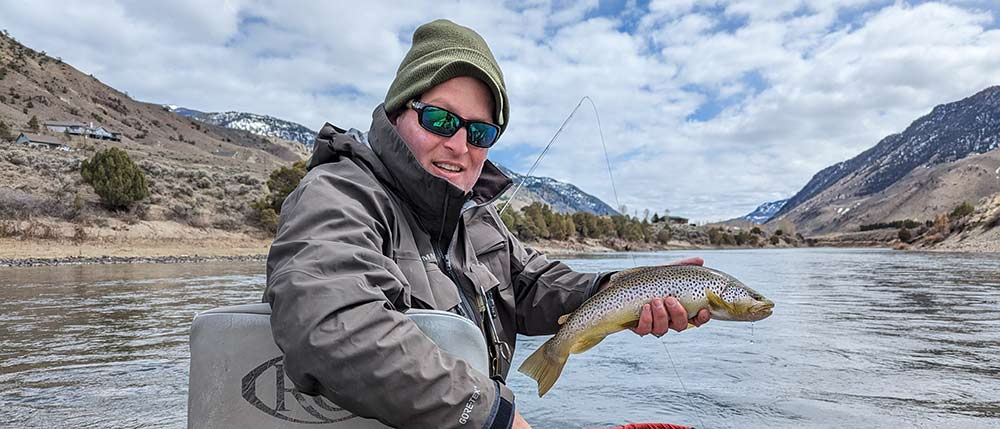
April is usually more a rainbow game (and I did catch a lot more rainbows and browns on this fun float with a buddy), but every once in a while a big brown will smoke a streamer as this one did.
Snowpack and Weather Outlooks
Long story short, we’ve had about a month worth of “actual winter” here in Livingston and in the Yellowstone area, and a week of that occurred in October. We had our largest snow storm of the year in the last week of October, as well as temperatures below zero. It didn’t get below zero again here until ten days ago. That cold (and wet) snap is now passing and it’s going to be in the 40s–50s here in Livingston for the next few days.
The warm, dry late autumn and start to winter leave us with extremely low snowpack across Montana. We’re actually doing better here in the Livingston-Bozeman-Yellowstone area than elsewhere in Montana. We currently have snowpack ranging from 59% to 63% of normal for the date in our core operations area. Points further northwest are lower. The Upper Clark’s Fork Basin is at a record-low 48% of normal, for example.
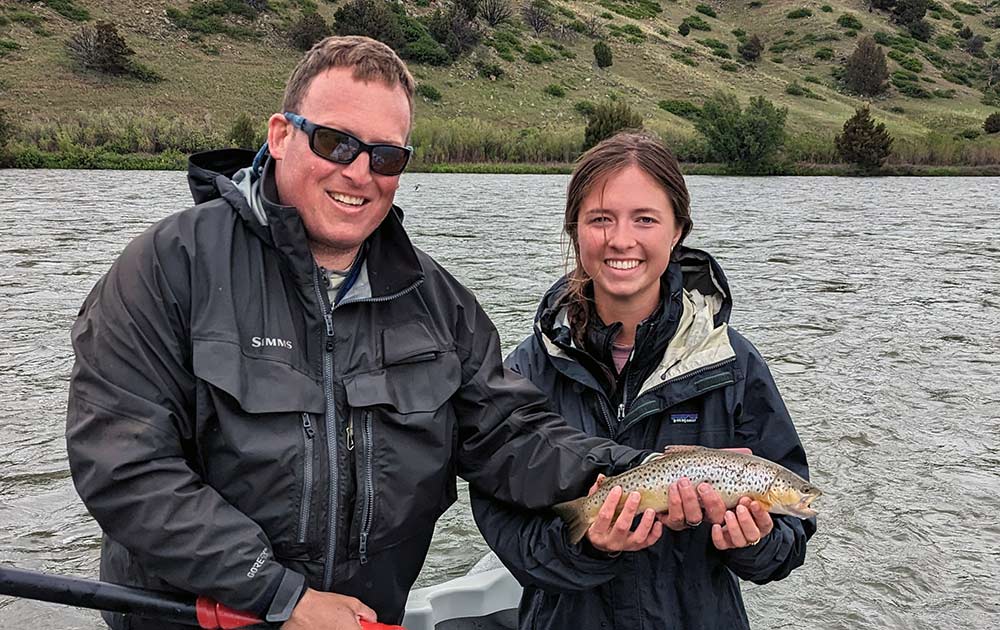
The Lower Madison fished well in late May and June. This might have been her first trout.
Current outlooks for the short (through January), medium (through February), and long term (through spring) are calling for continued warm and dry conditions, unfortunately.
All in all, it seems likely that we are likely to end up with half to two thirds our normal snowpack for the year. For comparison, we love to see around 110% of normal, and anything below 80% can make for tough late-summer conditions.
General Effects on Summer Fishing Streamflows and Fishing
If the above conditions come through as we unfortunately expect, we anticipate profound impacts on summer fishing. These are:
- Short and Limited Spring Runoff: Many waters such as the Madison and Boulder Rivers are unlikely to become unfishably muddy. Even the Yellowstone River (particularly in Yellowstone Park near Tower Falls) may only experience brief shots of dirty water.
- An Early End to Runoff: At the moment, we expect runoff to end no later than June 25 on all waters, even places like the Lamar which are seldom ready before July 4.
- Exceptional Fishing in Late June and Early July: While low-water years generally see tougher fishing in late summer, they usually see far better than average fishing in late June and early July. Our most recent year with conditions like we now expect for 2024 was 2021. June 20 through July 10, 2021 offered the best dry-dropper fishing we’ve ever seen on the Yellowstone River. We basically had a Salmonfly hatch and very early hopper fishing without having to cast into the bushes.
- Extreme Low Water in Late Summer: absent a very slow melt and abundant summer rain, it seems likely we’ll be looking at record-low or near record-low streamflows in late summer.
- Difficult Late Summer and Early Fall Fishing: Late summer and September 2021 offered the worst fishing we’ve ever had on the Yellowstone River. We’re talking about a handful of trout and whitefish on tiny nymphs, and not much else. The worst fishing will occur in early-mid August. Late August and September fishing will depend on light levels. Clouds mean solid fishing. Bright sun means tough fishing.
- Widespread Afternoon and Evening Fishing Restrictions: Because of the low flows, it seems almost certain we’ll have widespread 2PM to midnight “hoot owl” fishing closures throughout our operations area due to warm water, including on rivers like the Yellowstone where they are seldom necessary to protect the trout. These closures are most likely from July 25 through August 20. They could begin earlier and end later depending on the progress of the spring melt and summer heat.
- Widespread Fires and Extreme Fire Restrictions: In 2021, you could not smoke a cigarette unless standing on asphalt or in a river. We expect similar conditions this year. We also expect a lot of smoke, since most of the northwest and Canada is in as bad or worse shape than we are. The smoke actually helps water temps and fishing, since it functions like an overcast.
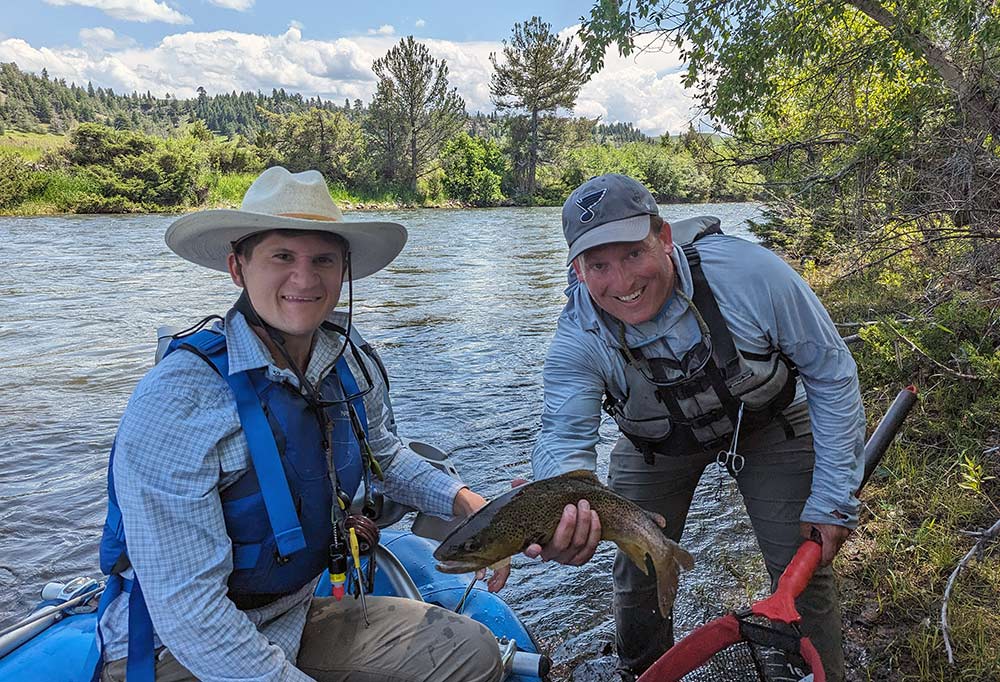
The Boulder River is only high enough to float for a short window, but it is probably our favorite river nowadays for about three weeks in late June and early July.
So What Do We Suggest?
This is not all doom and gloom, but it’s kind of doom and gloom. To work around likely poor conditions in late summer and early fall, we suggest the following if at all possible:
- Come Much Earlier in the Season, if Possible. See the “best fishing” info under the next heading for suggested target dates.
- If You Come in August or September, Please be Flexible. We are going to want to start early, fish rough or shady water, chase carp, and otherwise try to work around the low, warm water we expect to see. This will be especially important in August, but bright, hot, sunny days will see spooky and grumpy trout in September, too. The water will be plenty cold, but too low for them to be aggressive without cloud cover.
- Consider Coming in October: October fishing is awesome around here, and summer water conditions don’t really impact it. If you haven’t experienced the low crowds, BWO hatches, fall-run brown trout, and epic private lake fishing we often see in October, this is a good year to aim for it.
I’ll note here that waters near Missoula and especially near Glacier NP might actually be in worse shape and have earlier peaks and more restrictions than we will. The Glacier area is already in a prolonged drought, whereas our soil moisture is actually still good in the Yellowstone area.

This wasn’t a great big fish year on the Yellowstone, but this kid lucked into a nice one on his first day fly fishing.
End of Runoff and Expected Best Periods
Assuming continued drought conditions and a roughly-normal start date for the spring melt, here are our predictions for an ending date for the spring melt (signifying a start to summer fishing) and expected best fishing dates overall.
Montana Waters
- Yellowstone River: Runoff ends June 10–15, best fishing in late March and April, then again from June 20 through July 20. Occasional clear-water periods are likely even during runoff.
- Lower Madison River: No appreciable runoff. Best from mid-May through June 15. 24hr closures likely in July and August.
- Upper Madison River: No appreciable runoff. Best from early June through mid-July. 2PM closures possible in July and early August.
- Missouri River Tailwaters: No appreciable runoff. Flows have already been reduced on the “MO” to prepare for low inflows. 2PM closures possible in late July.
- Missouri River Headwaters (Carp): Best from late July through mid-September. Carp-fishing here is all sight-fishing, and the fish are 4–12lbs. Don’t you wanna give it a shot?
- Boulder River: Brief muddy water periods in late May and early June, but many fishable days even during this period. Runoff over by June 15. Fishing best June 15 through July 4, with flows too low to float by July 15.
- Stillwater River: Brief muddy water periods in late May and early June, but many fishable days even during this period. Runoff over by June 20. Fishing best July 15 through August 15, with flows too low to float by September 1. 2PM closures are likely but not certain after July 15.
- Mountain Creeks: Best from July 15 through August 15 and very low thereafter, though restrictions are unlikely.
- Spring Creeks: The low water will have no impact on the creeks except potentially increasing traffic. The best fishing will occur as always in late March and April and from June 25 through July 25.
- Private Lakes: Best from May 1 until June 15 unless we see an early 90-degree spell, which will end things when it hits.
- Public Lakes: Best in April and May, with extreme drawdowns in late summer.
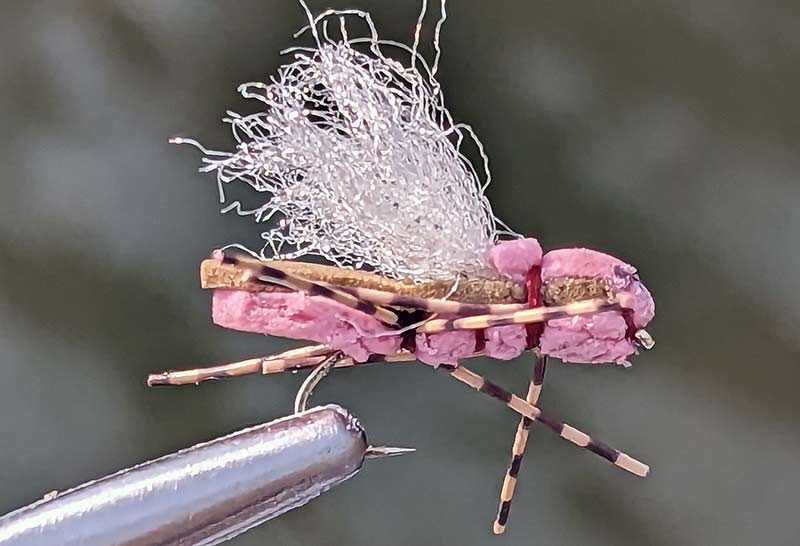
Last season’s top new fly was this updated version of my GFA hopper. More foam, more legs, and a white wing. The trout obviously approved!
Yellowstone Park Waters
- Firehole and Madison Rivers: Best from the season opener through June 15 and from September 15 until the roads close. No appeciable runoff. This water will be closed or should be from late June until Labor Day.
- Gibbon River (Below Norris): Best from the season opener through June 15, except possibly with a brief spot of dirty water between May 20 and the end of the month. Also good but not epic from September 15 until the roads close. This water will be closed or should be in July and August. Above Norris Geyser Basin, the Gibbon fishes like a small stream (see below).
- Gardner River: Best from June 15 through July 15, and from October 1 until the season ends. There will probably be sporadic periods of unfishable runoff in May and early June, but cool spells will drop the river back into shape throughout this period. Late-season fishing is almost always epic on this river.
- Yellowstone River (Grand Canyon): No or very brief unfishable runoff between May 20 and June 10 (if it stays clear, it will stay great). Great again from June 15 through July, but decent through September. Potential 2PM closures in late July and August. On sunny days in September, this will be our best trout fishery.
- Yellowstone River (Black Canyon): Runoff until June 10–15. Peak from June 20 through July 20. 2PM closures are likely in late July and August.
- Yellowstone River (Lake to Falls): Opens July 1 and likely as good as it ever gets for the three weeks thereafter.
- Slough Creek: Runoff ends June 15–20. Best from June 25 until July 20. Potential 2PM closures but likely very difficult fishing thereafter.
- Soda Butte Creek & Lamar River: Runoff ends June 20. Best from June 25 through July 25. Potential 2PM closures in late July and August. Fair but crowded fishing absent any closures.
- YNP Small Streams: Runoff ends June 5 to July 1, depending on the creek. Best for the month thereafter and very, very low in late summer. 2PM closures possible in late July and August.
- YNP Lakes: Best from ice-out (anywhere from May 1 to June 5, depending on the lake) for the month thereafter. Open but tough fishing from late July onward.
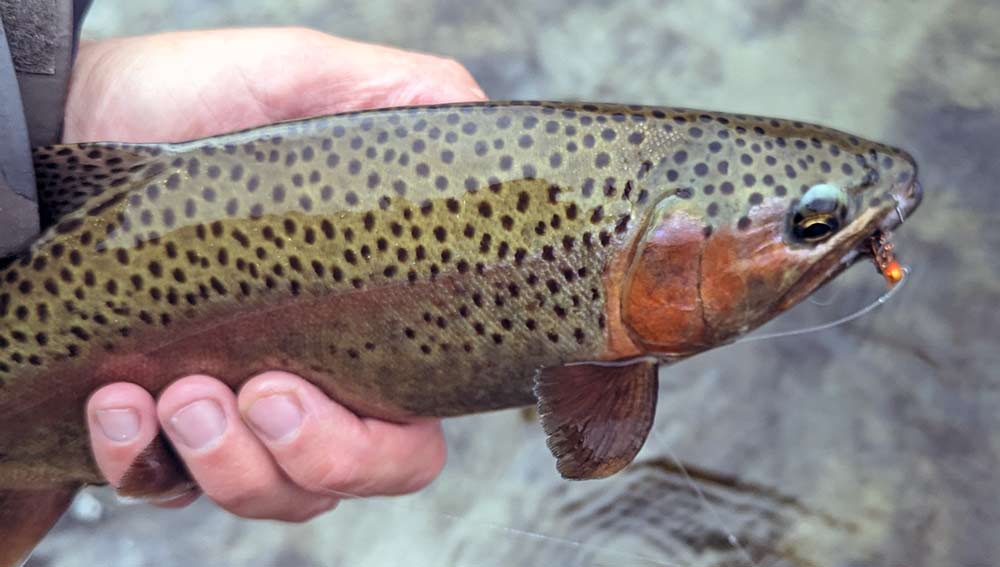
The late season is always great on the Gardner River. While I only caught a couple fall-run browns on this late October day, I landed 53 trout overall on my last day of the season on the Gardner, in only three hours. This rainbow was extra pretty, but otherwise not out of the ordinary.
The late season is always great on the Gardner River. While I only caught a couple fall-run browns on this late October day, I landed 53 trout overall on my last day of the season on the Gardner, in only three hours. This rainbow was extra pretty, but otherwise not out of the ordinary.
The Short Version
We are likely looking at extreme low snowpack and therefore extreme low water this season. While this will improve early summer fishing, it will hurt late summer and early autumn fishing.
In light of the above, I encourage clients planning trips this year to come during one of these three periods, if possible:
- In late March or especially April, before the spring melt.
- From mid-late June until roughly July 20
- As late in the fall as possible, preferably early October (for all fishing) or in October-November for wade-fishing.
We might be looking at tough fishing in late summer, or even widespread fishing closures. Early autumn won’t have the closures, but it will be very streaky. Cool, cloudy, smoky weather will be reasonably productive, but bright sun will make things tough.
Thanks for your business, and I hope to see you this (early) season.
I will post further snowpack and conditions updates beginning in a couple weeks.
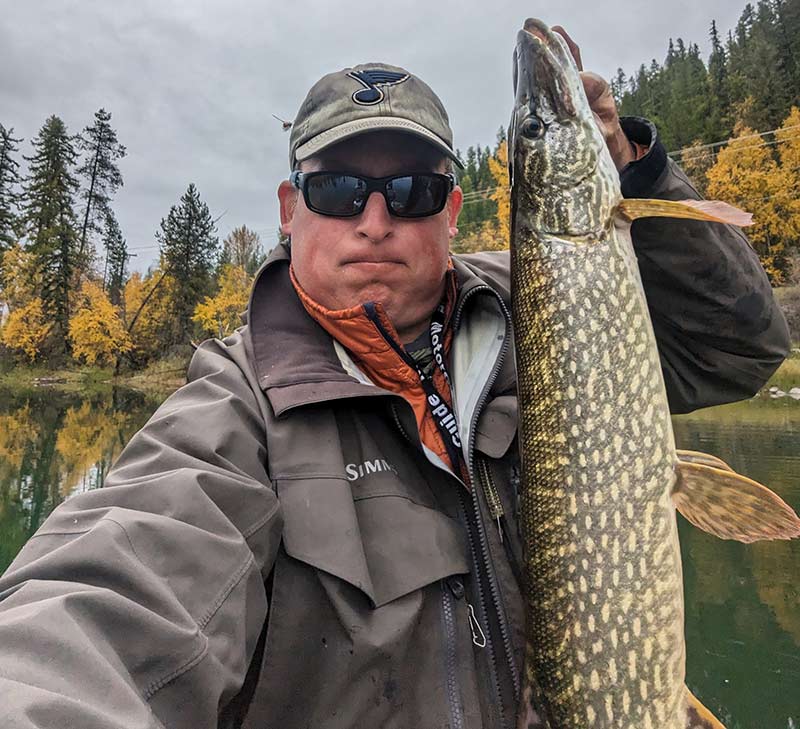
Nowhere near Yellowstone or Livingston, but an example of my latest obsession. I caught this one from the Swan River in northwest Montana.